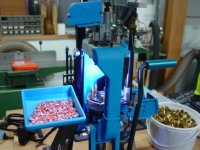Here's my life-long primer seating quest.
I started out reloading 45 years ago with a simple Lee tool. Those who have never used one might not believe that you primed the case by beating it out of the sizing die with a hammer and punch against a primer seating die. I had more than one primer go off on me.
Next came an RCBS Junior press. Primer seating on the stock press is kind of an afterthought, but it works. I didn't like seating primers on the upstroke of the handle in the stroke cycle where mechanical advantage is low. A primer feeding tube made the chore a little easier, but the quest continued.
An RCBS primer seating die held promise. It was a simple gadget that threaded in the conventional die location. A punch was snapped into the ram, and shell holders snapped on top of the die. It gave good primer seating feel, but care was needed not to crush primers as you had full press mechanical advantage. It was O.K., but didn't have a feeder tube. I got re-sizing lubricant on one primer and had my first and only failure to fire a reloaded round.
Next came the RCBS hand tool, which worked reasonably well. It had just the right mechanical advantage to make seating easy, was well made, but lacked a feeding tube.
The solution was a Lee Auto-Prime, essentially the same tool as the RCBS, but with a primer storage magazine. The Auto-Prime was cheaply made of pot metal and quickly wore out its load bearing pivots, degrading seating feel. It also required keeping track of extra shell holders.
I quit using all these tools when I started loading on a Forester press. The primer seating mechanism on a Forester seats primers easily and with good feel every time, doesn't need special shell holders, but lacks a feeder, necessitating handling each primer. I did it with tweezers to avoid oil contamination, but a better solution awaited.
I studied all the remaining priming gadgets on the market, and there are many. I was tempted by the RCBS strip priming tool, but in the end opted for the Forester tool. This is the last priming tool I will ever own. A feeding tray to hold 100 or so primers and no dies to fool with. The hand lever is makes extended sessions a breeze with no fatigue or loss of feel. It seats perfectly every time. It's a little more expensive than some, and maybe not as fast, but the most satisfying.



